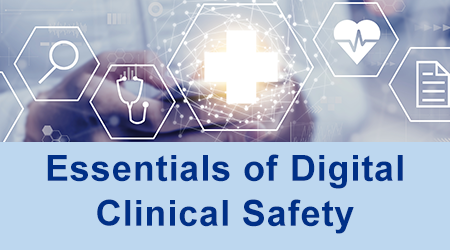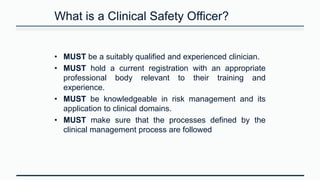The Responsibilities and Skills of a Clinical Safety Officer in Modern Healthcare Settings
The Responsibilities and Skills of a Clinical Safety Officer in Modern Healthcare Settings
Blog Article
Leading Responsibilities of a Professional Safety Policeman in Modern Medical Care
In the developing landscape of contemporary medical care, the role of a Scientific Safety and security Officer has ended up being significantly critical. These experts are charged with methodically recognizing and managing medical dangers, yet their duties expand much beyond simple oversight. From creating comprehensive safety and security methods to fostering a culture of safety within health care teams, their influence is profound. Moreover, as they browse the intricacies of governing conformity and team training, one have to consider how these efforts directly influence individual care results. What are the underlying difficulties they deal with in this multifaceted role, and how can they be effectively resolved?
Risk Analysis and Administration

The CSO collaborates with multidisciplinary groups to collect data on incidents and near misses out on, promoting a society of transparency and continual enhancement. By evaluating patterns and fads, the CSO can determine areas calling for treatment, eventually reducing the chance of negative events. In addition, the CSO makes certain compliance with governing requirements and guidelines, which offer to improve patient security and minimize responsibility dangers.
Efficient interaction is important; the CSO has to communicate risk searchings for to stakeholders, including health care companies, patients, and managers. Additionally, the CSO needs to remain abreast of emerging dangers connected with brand-new technologies and treatment techniques, adjusting threat management techniques appropriately. Inevitably, by promoting a setting of aggressive risk management, the Medical Security Policeman adds dramatically to the total safety and quality of care delivered within healthcare settings.
Developing Safety Procedures

In cooperation with multidisciplinary groups, the Clinical Security Officer examines data from occurrence reports and risk analyses to educate method advancement. This includes establishing clear, workable procedures for different situations, such as infection control, medicine administration, and emergency situation action. Guaranteeing that procedures are not only efficient yet also practical is essential; they need to be quickly recognized and integrated into everyday procedures.
Furthermore, the Medical Safety and security Officer stays upgraded on the current developments in safety actions and health care innovations, adjusting methods as necessary. Normal reviews and updates of these procedures are necessary to ensure they remain pertinent and effective in addressing emerging threats. Eventually, well-developed safety methods offer as a foundation for a society of safety and security, cultivating a setting where person care is prioritized and risks are systematically reduced.
Performing Training Sessions
While safety procedures give the structure for risk administration, performing effective training sessions is vital to make certain that all health care team excel in these protocols. A Clinical Safety and security Policeman plays a critical duty in developing and executing extensive training programs customized to the particular requirements of numerous groups within the healthcare setting. This includes arranging workshops, workshops, and hands-on training that attend to existing safety and security standards, emergency procedures, and the usage of safety devices.
Additionally, the Scientific Safety and security Officer should analyze the knowledge voids amongst team member, ensuring that training sessions are interesting and pertinent. Using a mix of training techniques, such as interactive simulations and study, can improve understanding and retention. Clinical safety officer. Routinely arranged training refreshers additionally boost staff readiness and adaptability to developing security procedures
Additionally, promoting a society of safety and security within the organization is crucial. The Medical Security Officer need to encourage open dialogue and responses throughout training sessions, allowing personnel to voice problems and share experiences. Ultimately, well-conducted training sessions equip healthcare specialists to react properly to potential dangers, promoting a more secure atmosphere for both people and staff.
Surveillance Compliance Requirements
Monitoring compliance requirements is integral to the function of a Scientific Security Officer, making sure that all safety procedures are regularly abided by across the health care center. This responsibility entails regular analyses of medical methods, plans, and procedures to align them Continue with well-known regulatory and business requirements.
The Medical Security Officer have to perform organized audits and evaluates to identify potential gaps in conformity, fostering an aggressive approach to person security. By implementing robust monitoring systems, the police officer can successfully track adherence to security protocols and rapidly deal with any kind of inconsistencies.
Furthermore, the Clinical Security Police officer teams up with numerous departments to make sure that all team member know and recognize conformity requirements. This consists of examining occurrence reports, evaluating risk monitoring techniques, and supplying feedback to improve practices.
Furthermore, the officer must stay upgraded on evolving healthcare regulations and requirements, guaranteeing that the facility adapts as necessary. By cultivating a society of liability, the Medical Safety Policeman plays a critical function in boosting the overall safety and security and high quality of care provided to people, eventually adding to better health and wellness outcomes and business stability.

Promoting a Society of Security
Producing a society of safety and security within a health care facility is vital for enhancing and lessening risks client treatment. A Professional Safety Police Officer resource (CSO) plays a pivotal function in cultivating this atmosphere by advertising liability, openness, and continual improvement among personnel whatsoever degrees. The CSO applies and creates security procedures that motivate open interaction and reporting of incidents without anxiety of .
To effectively advertise a society of security, the CSO has to take part in regular training sessions that emphasize the significance of person security and risk management. These sessions must include real-life study and simulations to assist team identify possible dangers and comprehend their duties in minimizing them. Furthermore, the CSO needs to assist in interdisciplinary partnership, ensuring that all departments work together to resolve safety and security problems thoroughly.
Regular assessments and feedback systems are essential parts of this society. The CSO should analyze safety data, identify fads, and share searchings for with the whole company to drive enhancement campaigns. By prioritizing safety and security, the CSO cultivates an atmosphere where personnel feel empowered to support for their clients, bring about enhanced treatment top quality and inevitably, far better health outcomes.
Verdict
In final thought, the function of a Clinical Security Officer is essential to promoting a safe medical care setting. By systematically determining professional threats, developing thorough safety and security methods, and performing specialized training, these specialists improve personnel preparedness and conformity with governing standards. Additionally, advertising a society of safety with open interaction and interdisciplinary cooperation significantly adds to enhanced patient treatment. Eventually, the initiatives of Clinical Safety and security Officers make certain that safety stays a critical emphasis within health care settings.
Eventually, by promoting a setting of positive risk management, the Scientific Safety and security Policeman contributes significantly to the general security and high quality of treatment delivered within health care setups.
Additionally, the Clinical Security Police officer stays updated on the most recent advancements in safety and security procedures and health care technologies, adapting methods accordingly. Ultimately, well-developed security methods offer as a structure discover here for a society of safety, promoting an environment where patient treatment is prioritized and dangers are systematically reduced.
To successfully advertise a culture of security, the CSO should involve in routine training sessions that stress the significance of patient safety and threat administration (Clinical safety officer). Ultimately, the efforts of Clinical Security Officers make certain that safety and security remains a vital emphasis within healthcare setups
Report this page